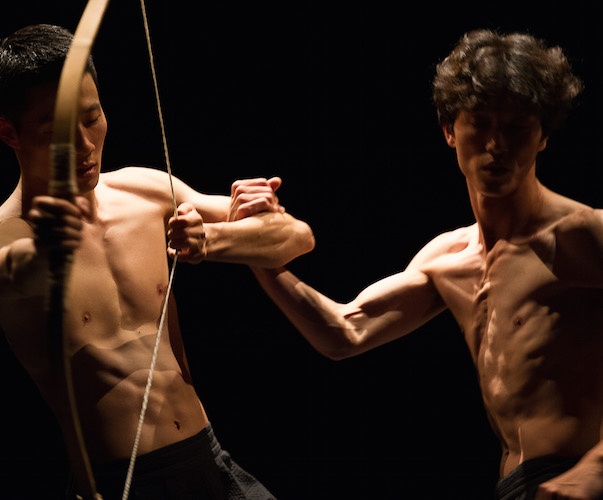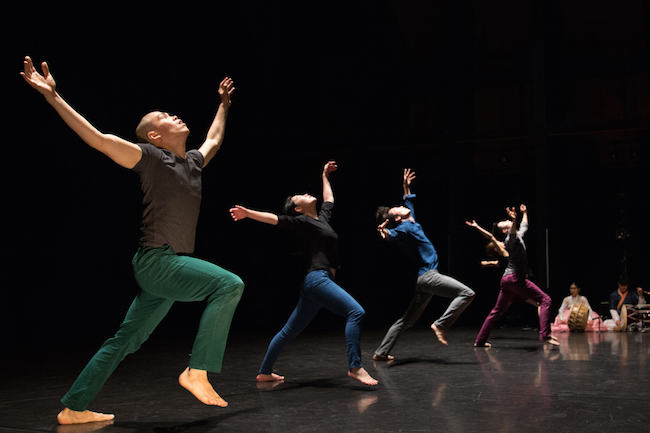Dance Review: Bereishit Dance Company — Cosmopolitan Grace
Soon-Ho Park’s dancers are young and seem imbued with the casual cosmopolitanism of their peers, but they and his dances reflect a deep seriousness and facility in their craft.
Bereishit Dance Company at Jacob’s Pillow Dance Festival, Becket, MA, through July 3. (Tickets start at $39.)

Jae-woo Jung and Cheol-in Jeong of Bereishit Dance Company in “Bow.” Photo: Christopher Duggan.
By Janine Parker
Soon-Ho Park’s Seoul-based Bereishit Dance Company is appearing at Jacob’s Pillow this week, performing two of the talented dancer/choreographer/teacher’s works. Park’s dancers are young and seem imbued with the casual cosmopolitanism of their peers, but they and his dances reflect a deep seriousness and facility in their craft. He is a man-of-the-world himself, with a movement style that draws on characteristics of modern dance — both post- and traditional — as well as the athleticism of street dance.
Park’s 2014 “Bow” is performed by two men, but the near-ubiquitous presence of the title object — here an archer’s instrument, not a musician’s tool — makes the dance seem more like a trio than a duet. And the way the dancers interact with the bow makes it seem as if it is a living presence. The subtle, long curves of a bow can resemble a dancer’s graceful lines. The way those curves disappear as the string pulls the bow into one big bloat — only to reappear intact and subtle again — is akin to a dancer’s flexibility, both taut and supple. This tension and release is tested in the physical and emotional relationship generated between the men, Cheol-in Jeong and Jae-Woo Jung. At the beginning of the piece, one end of the bowstring is unattached; there is a good deal of playing with the disassembled instrument. Alone, Jung draws the string between his legs and holds the end high up his back; et voilà, the bow protrudes from his pelvis, an impressive phallus indeed. When he’s with Jeong, the playing frequently has an edge, the string ending up briefly wrapped around one man’s throat.
Park’s program note states that the piece is primarily about the mechanics and “meditation” of the sport/art form of archery, but the visual metaphors of “Bow” — retraction and contraction, pull and push — speak volumes about the human dynamics of power, control, and acquiescence. The men are at times strangers, then buddies; adversaries, then colleagues; foes, then lovers. The ending is ambiguously charged: one may be the hunter, the other may be his victim.
Though in theory Jeong and Jung work together to attach the end of the string — they are, literally “attached at the hip” when they do so — they’re also both trapped by one another. In one of Park’s many creative partnering sections, one man scissors the other’s hips — the man-in-a-grip transports his unwieldy burden over to the bow and once there bends his knees and folds his torso over the other man so that he can finally reach far enough down for the two to hook the bowstring. It’s an exhausting and yet funny scene.
In a somewhat different, longer (and presumably earlier) version that I viewed online, the piece began with the men—in handsome white costumes of pants and embroidered shirts—holding the already-assembled bow between them, dancing with upright solemnity. This formality lent a keen aura of melancholy to the work, while the comparative “nakedness” in the shorter Pillow version — the men wear black sweatpants and the bow is disassembled — immediately clarifies the manipulative dimension of the men’s encounter. The online version’s opening dance is, at the Pillow, performed last.
It’s interesting to see “Bow” unfold both ways. Each version is filled with fascinating images. Jeong and Jung are terrific. The men at times seem to melt onto each other, boneless, or catapult off of one another, weightless and strong, all at once. Still, even such gorgeousness is nearly killed by Park’s unfortunate choice of music, a melodramatic composition by Luduvico Einaudi, with swelling strings that I suppose are meant to sound heroic — or make you want to buy a luxury sedan. But to my ear, and particularly in a concert dance piece, it just sounds overwrought.

Ji-soo Ryu, So-yeon Kim, Cheol-in Jeong, and Jae-woo Jung of Bereishit Dance Company of “Balance and Imbalance.” Photo: Hayim Heron.
According to the company’s bio, the interplay of traditional and contemporary culture is one of the troupe’s guiding principles. In the Pillow show, the tension between the two is most manifestly presented in the contrasting costumes and material of Park’s “Balance and Imbalance” a 2010 work for five dancers and three musicians. The dancers are garbed in variations on casual urban wear while the musicians — two male drummers and a female vocalist — are costumed in formal Korean dress. Likewise, the (male) drummers, sitting far downstage left, play traditional music with traditional instruments and the female vocalist recites and sings in the storytelling genre called pansori.
Although the two are separate pieces, “Balance” began with Jeong and Jung meeting in the middle of the stage and shaking hands, which made me imagine they were apologizing for whatever happened after the lights went out in “Bow.” But when the handshake became a push, the struggle for dominance began anew. The piece very loosely takes its cues from the fabled battles between the tortoise and the hare; the program notes include an excerpted translation of a traditional Korean fable, the “Sugungga,” which vocalist Seo-hee Lee recites (at least, I assume that’s what she’s reciting in Korean). Park’s dexterity and invention with partnering is prominent in “Balance” too. Three likewise superb dancers join Jeong and Jung in “Balance,” Ji-soo Ryu and two women, So-yeon Kim and Da-som Lee. Sometimes, one dancer will run toward two others who catch and swoop her/him up swiftly, into a glorious high arc. The riskiness of this is breathtaking — and addictive. Park obliges, and throws a few more swoop lifts in, but he doesn’t make the mistake of too much repetition, nor does he need to. He’s got plenty of compelling ideas. In one solo, Ryu poses like a self-conscious bodybuilder, but moves about like he’s a puppet on strings. The obvious implication is that his movements are controlled by an outside force, which conversely only goes to show that Ryu is just doing what good dancers always do: moving from deep within.
Some of the choreography in this relentless fight for the upper hand conjures up a boxing match. Sometimes the dancers hop in a wide parallel, as if they’re biding their time in the ring. And there’s the occasional ringing of a single bell, clear and simple yet somewhat ominous. Finally, though, nothing bad happens. The dancers project cool, but it’s only an armor. Toward the end, the five dancers, spread out in a horizontal line, travel downstage and upstage in a mostly unison sequence filled with both staccato, punched gestures and sensually fluid curves. Is it a cliché that they advance upon the audience and glower for a moment before heading back upstage into individual circles of light? Maybe, but from where I was sitting, as they swooned and straightened, swooned and straightened, swooned and straightened, in the slowly darkening stage, it just looked beautiful.
Since 1989, Janine Parker has been writing about dance for The Boston Phoenix and The Boston Globe. A former dancer, locally she performed with Ballet Theatre of Boston, North Atlantic Ballet, Nicola Hawkins Dance Company, and Prometheus Dance. Ms. Parker has been teaching for more than 25 years, and has a long history with Boston Ballet School. She is on the Dance Department faculty of Williams College in Western Massachusetts, where she has lived since 2003. Janine Parker can be reached at parkerzab@hotmail.com.
